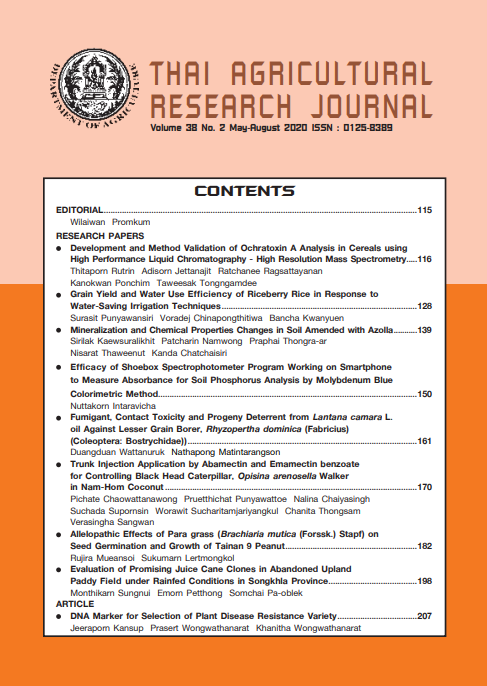Mineralization and Chemical Properties Changes in Soil Amended with Azolla
DOI:
https://doi.org/10.14456/thaidoa-agres.2020.10Keywords:
Mineralization, Ammonium, Nitrate, AzollaAbstract
Azolla is a kind of bio-fertilizer that can be used as a nitrogen source for plants. It also contained high amount of other macro nutrients, which when decomposed will release them to the soils. Azolla can be used in both fresh and dried form, This research was to study the mineralization of plant nutrients and the change in chemical properties in soil amended with fresh and dried Azolla. Fresh and dried Azolla were incubated in soil (Pak Chong series) at the temperature of 30 °oC, water holding capacity of 60% for 154 days. Results revealed that in soil amended with fresh Azolla, amount of ammonium-N was higher than nitrate-N during the first 35 days of incubation period. After that, amount of ammonium-N declined, and by the end of the study time all was mineralized to nitrate-N. In comparison, the amount of mmonium-N in the soil amended with dried Azolla was higher than nitrate-N only during the first 7 days then declined, thus enabled nitrate-N accumulation till the end of the study. Mineralization of phosphorus and potassium occurred in the similar pattern as that of nitrogen. The amount of available phosphorus and exchangeable potassium was found higher in the soil amended with dried Azolla than that amended with the fresh one. Mineralization of phosphorus and potassium occurred in more than 150 days of the study. We also found that soil amended with both fresh and dried Azolla had slightly lower pH but higher organic matter accumulation when compared with the unamended soil. However, the soil amended with dried Azolla had higher soil EC than that amended with fresh one.
References
กรมวิชาการเกษตร. 2553. คำแนะนำการใช้ปุ๋ยกับพืชเศรษฐกิจ. กรุงเทพฯ. 122 หน้า.
ประพิศ แสงทอง และพิชิต พงษ์สกุล. 2536.ความเป็นประโยชน์ของไนโตรเจนจากแหนแดง. ว. ดินและปุ๋ย. 15: 173-181.
ศิริลักษณ์ แก้วสุรลิขิต และประไพ ทองระอา. 2557. การใช้แหนแดงเพื่อการผลิตพืช. หน้า 128-135. ใน: เอกสารประกอบการ
ประชุมวิชาการ ปี พ.ศ. 2557 สำนักวิจัยพัฒนาปัจจัยการผลิตทางการเกษตร กรมวิชาการเกษตร 10-12 มิถุนายน 2557 ณ โรงแรมเดอะกรีนเนอรี่ รีสอร์ท เขาใหญ่อำเภอปากช่อง จังหวัดนครราชสีมา.
ศิริลักษณ์แก้วสุรลิขิต ประไพ ทองระอา กานดา ฉัตรไชยศิริ และภาสันต์ ศารทูลทัต. 2561. ผลของแหนแดงแห้งต่อการเจริญเติบโตของผักกวางตุ้ง. หน้า 332-337.ใน: เอกสารการประชุมวิชาการพืชสวนแห่งชาติ ปี ครั้งที่ 17, 9-21 พฤศจิกายน 2561 ณ โรงแรมเชียงใหม่ แกรนด์วิวแอนด์คอนเวนชั่น เซ็นเตอร์จังหวัดเชียงใหม่.
Bhardwaj, K.K.R.and A.C. Gaur.1970. Effect of humic and fulvic acids on the growth and efficiency of nitrogen
fixationby Azotobacter chroococcum. Folia Microbiol.15: 364-367.
Bray, R.H. and N. Kurtz.1945. Determination of total organic and available forms of phosphorus in soil. Soil Sci.
: 39-45.
Goering, H.K. and P.J. van Soest, 1970. Forage fiber analyses (apparatus, reagents, procedures, and some
applications). Agriculture handbook no. 379, Agriculture Research Service USDA, Washington (DC),USA. 20 pp.
Ito, O. and I. Watanabe. 1985. Availability to rice plants of nitrogen fixed by Azolla. Soil Sci. Plant Nutr. 31:
-104.
Jumadi, O.; F. Hiola; Y. Hala; J. Norton and K. Inubushi. 2014. Influence of Azolla (Azolla microphylla Kaulf.)
compost onbiogenicgasproduction, inorganic nitrogen and growth of upland Kangkong (Ipomoea aquatica Forsk.) in a silt loam soil. Soil Sci. Plant Nutr. 60: 722–730.
Keeney, D.R. 1982. Nitrogen-availability indexes. Pages711-733. In: Methods of soil analysis Part 2. 2nd Ed. A.L.
Page; R.H. Miller and D.R. Keeney American Society of Agronomy, Madison, WI.
Van Hove, C. 1989. Azolla and its multiple uses with emphasis on Africa. FAO, Rome, Italy. 53 p.
Walkley, A.andI. A. Black.1947. Chromicacid titration method for determination of soilorganic matter. Soil Sci. Amer. Proc. 63: 257.
Watanabe, I., B. Ke-Zhi, N.S. Benja, C.R. Espinas, O. Ito and B.P.R. Subudhi. 1981. The Azolla anabaena complex
and its use in rice culture. IRPS. 69: 1-11.
Watanabe, I., C.R. Espianas, N.S. Berja and B.V. Alimagno. 1977. The utilization of the Azolla-Anabaena complex as anitrogenfertilizer for rice. IRRI Res.11: 1-15.
Watanabe, I. and C. Ramirez. 1990. Phosphorus and nitrogen contents
of Azolla grown in the Philippines. Soil Sci. Plant Nutr. 36: 319–331.
Watanabe, I., N.S. Berja and D.C. Del Rosario. 1980. Growth of Azolla in paddy field as affected by
phosphorus fertilizer. Soil Sci. Plant Nutr. 26: 301-307.
Watanabe, I., P.Jr. Benjaminand C. Ramirez. 1991. Mineralization of Azolla N and its availability to wetland rice.
Soil Sci. Plant Nutr. 37: 679-688.
Wen, Q.X., L.L. Cheng and S.L. Shi 1987. Decomposition of Azolla in the field and availability of Azolla nitrogen to
plants. Pages 241-254. In: Azolla utilization, Ed. IRRI. Manila, Philippines
Downloads
Published
How to Cite
Issue
Section
License
Thai Agricultural Research Journal



